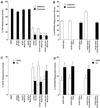Differential modulation of BMP signaling promotes the elaboration of cerebral cortical GABAergic neurons or oligodendrocytes from a common sonic hedgehog-responsive ventral forebrain progenitor species
- PMID: 12461181
- PMCID: PMC138601
- DOI: 10.1073/pnas.232586699
Differential modulation of BMP signaling promotes the elaboration of cerebral cortical GABAergic neurons or oligodendrocytes from a common sonic hedgehog-responsive ventral forebrain progenitor species
Abstract
During cerebral cortical development, excitatory glutamatergic projection neurons are generated from neural stem cells intrinsic to the early embryonic cortical ventricular zone by a process of radial migration, whereas most inhibitory gamma-aminobutyric acid (GABA)ergic interneurons and oligodendrocytes (OLs) appear to be elaborated from ventral forebrain stem cells that initially undergo tangential cortical migration before terminal lineage maturation. In contrast to the more compartmentalized developmental organization of the spinal cord, the generation of neurons and OLs from a common ventral forebrain stem cell would expose these cells to the sequential actions of ventral and dorsal gradient morphogens [sonic hedgehog (Shh) and bone morphogenetic proteins (BMPs)] that normally mediate opposing developmental programs. Here we report that Shh promotes GABAergic neuronalOL lineage restriction of forebrain stem cells, in part, by activation of the basic helix-loop-helix transcription factors, Olig2 and Mash1. In mutant mice with a generalized defect in tangential cortical migration (Dlx12--), there is a profound and selective reduction in the elaboration of both cortical GABAergic neurons and OLs. Our studies further demonstrate that the sequential elaboration of cortical GABAergic neurons and OLs from common Shh-responsive ventral forebrain progenitors requires the spatial and temporal modulation of cortical BMP signaling by BMP ligands and the BMP antagonist, noggin, respectively. These findings suggest an integrative model for cerebral cortical GABAergic neuronal and OL lineage maturation that would incorporate the sequential contributions of the ventral and dorsal forebrain, and the potential role of regional developmental cues in modulating transcriptional codes within evolving neural lineage species.
Figures




Similar articles
-
Hedgehog-dependent oligodendrocyte lineage specification in the telencephalon.Development. 2001 Jul;128(13):2545-54. doi: 10.1242/dev.128.13.2545. Development. 2001. PMID: 11493571
-
Isolation of a novel platelet-derived growth factor-responsive precursor from the embryonic ventral forebrain.J Neurosci. 2004 Dec 1;24(48):10888-99. doi: 10.1523/JNEUROSCI.3302-04.2004. J Neurosci. 2004. PMID: 15574739 Free PMC article.
-
Induction of oligodendrocyte progenitors in dorsal forebrain by intraventricular microinjection of FGF-2.Dev Biol. 2006 Sep 1;297(1):262-73. doi: 10.1016/j.ydbio.2006.05.017. Epub 2006 May 19. Dev Biol. 2006. PMID: 16782086
-
Mechanisms regulating lineage diversity during mammalian cerebral cortical neurogenesis and gliogenesis.Results Probl Cell Differ. 2002;39:27-52. doi: 10.1007/978-3-540-46006-0_2. Results Probl Cell Differ. 2002. PMID: 12357985 Review.
-
[Common mechanism underlying oligodendrocyte development and oligodendrogliomagenesis].Brain Nerve. 2009 Jul;61(7):741-51. Brain Nerve. 2009. PMID: 19618851 Review. Japanese.
Cited by
-
Origins of cortical interneuron subtypes.J Neurosci. 2004 Mar 17;24(11):2612-22. doi: 10.1523/JNEUROSCI.5667-03.2004. J Neurosci. 2004. PMID: 15028753 Free PMC article.
-
REST and CoREST modulate neuronal subtype specification, maturation and maintenance.PLoS One. 2009 Dec 7;4(12):e7936. doi: 10.1371/journal.pone.0007936. PLoS One. 2009. PMID: 19997604 Free PMC article.
-
Early neuronal and glial fate restriction of embryonic neural stem cells.J Neurosci. 2008 Mar 5;28(10):2551-62. doi: 10.1523/JNEUROSCI.5497-07.2008. J Neurosci. 2008. PMID: 18322099 Free PMC article.
-
Molecular and morphological changes in zebrafish following transient ethanol exposure during defined developmental stages.Neurotoxicol Teratol. 2014 Jul-Aug;44:70-80. doi: 10.1016/j.ntt.2014.06.001. Epub 2014 Jun 11. Neurotoxicol Teratol. 2014. PMID: 24929233 Free PMC article.
-
Specification of CNS glia from neural stem cells in the embryonic neuroepithelium.Philos Trans R Soc Lond B Biol Sci. 2008 Jan 12;363(1489):71-85. doi: 10.1098/rstb.2006.2013. Philos Trans R Soc Lond B Biol Sci. 2008. PMID: 17282992 Free PMC article. Review.
References
-
- Tan S.-S., Kalloniatis, M., Sturm, K., Tam, P. P. L., Reese, B. E. & Faulkner-Jones, B. (2001) Neuron 21, 295-304. - PubMed
-
- Parnavelas J. G. (2000) Trends Neurosci. 23, 126-131. - PubMed
-
- Corbin J. G., Nery, S. & Fishell, G. (2001) Nat. Neurosci. 4, 1177-1182. - PubMed
-
- Marin O. & Rubenstein, J. L. R. (2001) Nat. Neurosci. Rev. 2, 780-790. - PubMed
-
- Anderson S. A., Marin, O., Horn, C., Jennings, K. & Rubenstein, J. L. R. (2001) Development (Cambridge, U.K.) 128, 358-363. - PubMed
Publication types
MeSH terms
Substances
Grants and funding
LinkOut - more resources
Full Text Sources
Other Literature Sources
Molecular Biology Databases

